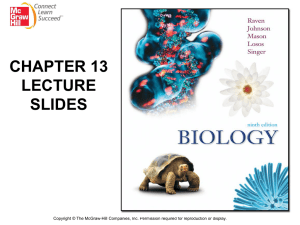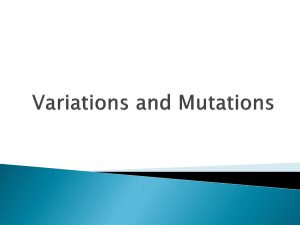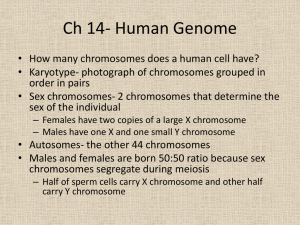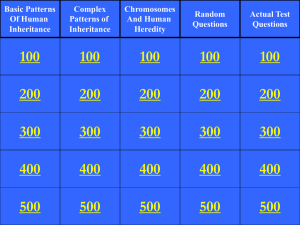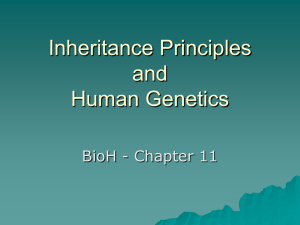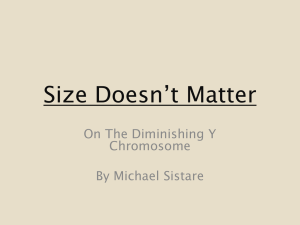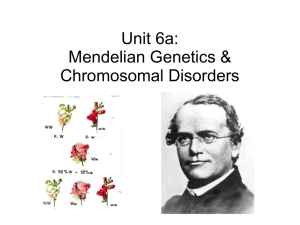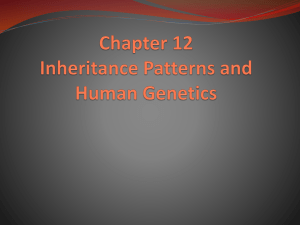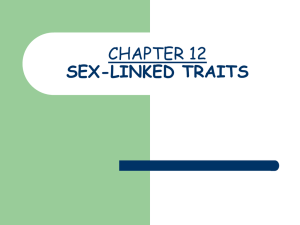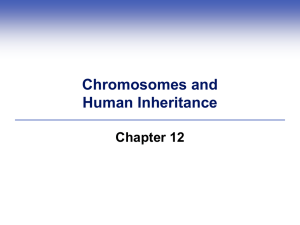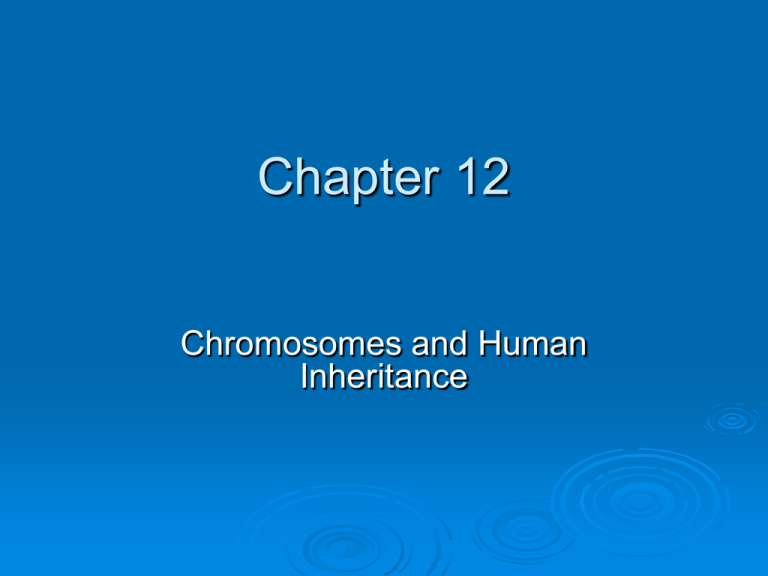
Chapter 12
Chromosomes and Human
Inheritance
Objectives
1. Describe how an understanding of chromosomes
helps to account for events that compose mitosis and
meiosis.
2. Name some ordinary and extraordinary chromosomal
events that can create new phenotypes (outward
appearances).
3. Understand how changes in chromosome structure
and number can affect the outward appearance of
organisms.
4. Distinguish autosomal recessive inheritance from sexlinked recessive inheritance.
Objectives
5. Give examples of each of the above types of
inheritance.
6. Discuss how fruit fly experiments have
helped us understand chromosomal behavior.
7. Explain how changes in chromosomal
number can occur and present an example of
such a change.
8. List examples of phenotypic defects and
describe how each can be treated.
Objectives
9. Explain how knowing about modern methods
of genetic screening can minimize potentially
tragic events.
12.0 Strange Genes, Tortured
Minds
Neurobiological
disorders (NBDs) include
schizophrenia, depression, bipolar
disorder, and autism.
Schizophrenia is a neurobiological
disorder (1 of every 100 people)
Symptoms: delusions, hallucinations,
disorganized speech, abnormal social
behavior
Strange Genes, Richly Tortured
Minds
Emotionally
healthy people who show
creative brilliance tend to have personality
traits in common with the mentally
impaired (p186)
Altered
gene expression in certain brain
regions may boost creativity as well as
invite illness (p187)
12.1 Human Chromosomes
Some
genes on chromosomes control cell
growth and division
If
something affects chromosome structure
at or near these loci, cell division may
spiral out of control
This
can lead to cancer
Genes
Units
of information about heritable traits
In
eukaryotes, distributed among
chromosomes
Each
has a particular locus
Location on a chromosome
Homologous Chromosomes
Homologous
autosomes are identical in
length, size, shape, and gene sequence
Sex chromosomes are nonidentical but
still homologous (Human X & Y)
Homologous chromosomes interact,
then segregate from one another during
meiosis
Alleles
Different
Arise
molecular forms of a gene
through mutation
Diploid
cell has a pair of alleles at each
locus
Alleles
on homologous chromosomes may
be same or different
Sex Chromosomes
Discovered
Mammals,
In
in late 1800s
fruit flies
XX is female, XY is male
other groups XX is male, XY female
Human
X and Y chromosomes function as
homologues during meiosis
12.2 Karyotype Preparation Stopping the Cycle
Cultured
cells are arrested at metaphase
by adding colchicine – a poison that
prevents microtubules from forming.
This
is when cells are most condensed
and easiest to identify
Karyotype Preparation
Arrested cells are broken open
Metaphase chromosomes are fixed
and stained
Chromosomes are photographed
through microscope
Photograph of chromosomes is cut
up and arranged to form karyotype
diagram
Karyotype Diagram
Fig. 12-3f, p.189
Philadelphia Chromosome
First abnormal chromosome to be associated
with a cancer (Spectral Karyotype using
colored fluorescent dyes.
Reciprocal translocation
Causes chronic myelogenous leukemia
(CML)
12.3 Autosomal
Dominant Inheritance
Trait typically
appears in
every
generation
Fig. 12-10a, p. 190
Huntington Disorder
Autosomal dominant allele
Causes involuntary movements, nervous system
deterioration, death
Symptoms don’t usually show up until person is
past age 30
People often pass allele on before they know
they have it
Achondroplasia
Autosomal
dominant allele
In
homozygous form usually leads to
stillbirth
Heterozygotes
Have
display a type of dwarfism
short arms and legs relative to other
body parts
Autosomal Recessive
Inheritance Patterns
If
parents are
both
heterozygous,
child will have a
25% chance of
being affected
Fig. 12-10b, p. 191
Galactosemia
Caused by autosomal recessive allele
Gene specifies a mutant enzyme in the
pathway that breaks down lactose – may lead
to death if not treated.
enzyme 1
lactose
enzyme 3
enzyme 2
galactose
+
glucose
galactose-1phosphate
galactose-1phosphate
intermediate
in glycolysis
12.4 Hutchinson-Gilford
Progeria
Mutation
No
causes accelerated aging
evidence of it running in families
Appears
to be dominant (1 out of 8 million
births.)
Seems
to arise as spontaneous mutation
Usually
causes death in early teens
Sex determination: The Y
Chromosome
Carries
255 genes, one is the master
gene for male sex determination
SRY gene (sex-determining region of Y)
SRY
present, testes form
SRY
absent, ovaries form
The X Chromosome
Carries
1,141 genes
Most
genes deal with nonsexual traits, ex.
Blood clotting factors.
Genes
on X chromosome can be
expressed in both males and females
diploid
germ cells
in female
diploid
germ cells
in male
meiosis, gamete
formation in both
female and male:
eggs
Sex
Determination
sperm
X
x
Y
X
x
X
Fertilization:
X
X
X
XX
XX
X
XY
XY
sex chromosome
combinations
possible in new
individual
Fig. 12-8a, p.192
12.6 X-linked Inheritance
Thomas Morgan Embryologist –
discovered sex-linked outcomes of
hemophilia in males.
fruit fly’s X chromosome has
the gene for eye color and another gene
for body color (p193)
Reciprocal crosses
Drosophila,
homozygous dominant
female
Discovering
Linkage
recessive male
x
Gametes:
X
X
X
Y
All F1
have red eyes
Gametes:
x
X
X
1/2
1/2
1/4
1/2
F2
generation:
X
1/2
1/4
1/4
1/4
Y
12.7 X-Linked Recessive
Inheritance
Males
show
disorder more
than females
Son cannot inherit
disorder from his
father
Fig. 12-10, p.194
Examples of X-Linked Traits
Color
blindness (Red-Green)
Inability to distinguish among some of all
colors
Hemophilia
Blood-clotting disorder
1/7,000 males has allele for hemophilia A
Was common in European royal families
Color Blindness
Fig. 12-12, p.195
Hemophilia
Fig. 12-11, p.194
Father with Hemophilia and Mother
Carrier Genetics
Fragile X Syndrome
An
X-linked recessive disorder
Causes
mental retardation
Mutant
allele for gene that specifies a
protein required for brain development
Allele
has repeated segments of DNA
12. 8 Duplication
Gene
sequence that is repeated several to
hundreds of times
Duplications
occur in normal
chromosomes
May
have adaptive advantage
Useful mutations may occur in copy
Duplication
normal chromosome
one segment
repeated
three repeats
Deletion
Loss
of some segment of a chromosome
Most are lethal or cause serious disorder
Deletion
Cri-du-chat
Fig. 12-13, p.196
Inversion
A linear stretch of DNA is reversed
within the chromosome
segments
G, H, I
become
inverted
In-text figure
Page 196
Translocation
A
piece of one chromosome becomes
attached to another nonhomologous
chromosome
Most are reciprocal
Philadelphia chromosome arose from a
reciprocal translocation between
chromosomes 9 and 22
Translocation
one chromosome
a nonhomologous
chromosome
nonreciprocal translocation
In-text figure
Page 206
In-text
figure
Chromosome Structure
Alterations
to chromosome structure are
usually bad
Duplications
are adaptive: one gene
functions normally - the other is free to
mutate
Chromosome
structure evolves
Chromosome Structure
Human body cells have 23 pairs of
chromosomes
Chimpanzees, gorilla, or orangutan body cells
have twenty-four pairs of chromosomes
During human evolution, two chromosomes in
an early ancestor fused to form chromosome 2
(p197)
Chromosome
Structure
human chimpanzee gorilla
orangutan
Fig. 12-15, p.197
12.9 Aneuploidy
Individuals
have one extra or less
chromosome
(2n + 1 or 2n - 1)
Major cause of human reproductive
failure
Most human miscarriages are
aneuploids
Polyploidy
Individuals
have three or more of each
type of chromosome (3n, 4n)
Common
Lethal
in flowering plants
for humans
99% die before birth
Newborns die soon after birth
Nondisjunction
n+1
n+1
n-1
chromosome
alignments at
metaphase I
n-1
nondisjunction alignments at
at anaphase I metaphase II
anaphase II
Figure 12.16
Page 198
Down Syndrome
Trisomy
of chromosome 21
Mental
impairment and a variety of
additional defects
Can
Risk
be detected before birth
of Down syndrome increases
dramatically in mothers over age 35
Down Syndrome
Fig. 12-17, p.199
Turner Syndrome
Inheritance
98%
of only one X (XO)
spontaneously aborted
Survivors
are short, infertile females
No functional ovaries
Secondary sexual traits reduced
May be treated with hormones, surgery
Klinefelter Syndrome
XXY
condition
Results mainly from nondisjunction in
mother (67%)
Phenotype is tall males
Sterile or nearly so
Feminized traits (sparse facial hair, somewhat
enlarged breasts)
Treated with testosterone injections
XYY Condition
Taller
Most
otherwise phenotypically normal
Some
Once
than average males
mentally impaired
thought to be predisposed to
criminal behavior, but studies now
discredit
male
12.10
Pedigree
Symbols
female
marriage/mating
offspring in
order of birth,
from left to right
Individual showing
trait being studied
sex not
specified
I, II, III, IV...
generation
Fig. 12-19a, p.200
Pedigree for Polydactyly
female
I
male
II
5,5
6,6
*
III
IV
5,5
6,6
6
6,6
5,5
6,6
5,5
7
5,5
6,6
5,5
6,6
5,5
6,6
5,5
6,6
5,6
6,7
12
V
*Gene not expressed in this carrier.
6,6
6,6
Fig. 12-9b, p. 200
Genetic Abnormality
A
rare, uncommon version of a trait
Polydactyly
Unusual number of toes or fingers
Does not cause any health problems
View of trait as disfiguring is subjective
Genetic Disorder
Inherited
conditions that cause mild to
severe medical problems
Why
don’t they disappear?
Mutation introduces new rare alleles
In heterozygotes, harmful allele is masked, so
it can still be passed on to offspring
Genetic Disorders and Genetic Abnormalities
12.11 Phenotypic Treatments
Symptoms
of many genetic disorders can
be minimized or suppressed by
Dietary controls
Adjustments to environmental conditions
Surgery or hormonal treatments
Genetic Screening
Large-scale
screening programs detect
affected persons
Newborns
in United States routinely
tested for PKU
Early detection allows dietary intervention
and prevents brain impairment
Prenatal Diagnosis
Amniocentesis
Chorionic villus sampling
Fetoscopy
All methods have some risks
Preimplantation Diagnosis
Used
with in-vitro fertilization
Mitotic
All
divisions produce ball of 8 cells
cells have same genes
One
of the cells is removed and its
genes analyzed
If
cell has no defects, the embryo is
implanted in uterus

